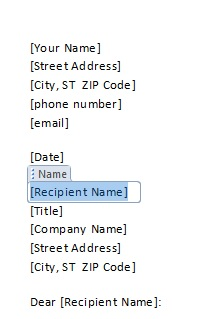(To see previous articles in this series, go here.)
Once you have crafted your messaging, it is time to develop its presentation!
While formatting is seemingly a secretarial task, I would caution you not to use templates where you just insert your information. When someone else opens up your letter on their computer, it is going to show those “boxes”, and they will know you used a template form. It is extremely impersonal.

It might be a great idea to print out that template and use it as a reference for spacing, but instead of using it, open a blank document (no form boxes that you insert information), and write/edit it manually.
Standard business letter rules should be followed (my personal favorite is the Gregg Reference Manual). Keep your font black, and be sure to use a common font and font size of size 11 or 12. Be kind to your reader, and don’t use a tiny font that will make them squint to read it!
For uniformity and consistency, I also highly recommend you use the same top (header), and margin size that matches your resume. It will look better on those occasions you/they print it out.
Though there are a plethora of cover letter examples in books and on the internet, these should only be used as EXAMPLES to glean ideas from, not copied! It is vital that your materials be personalized to sell you as a unique individual on the market!
Your cover letter should be no longer than one page, and should be no more than two to three paragraphs.
- Paragraph 1 is: ‘Hey, I am the answer to your problem and here’s why.” (It is also a good idea to name the specific position title or job number.)
- Paragraph 2 is: “Here, is the proof of why I am the answer to your problem.” Sometimes you need a Paragraph 2A, but not often. It is a good idea to review the job description and match up your qualifications and how they correspond to their needs. Some use bullet points or list items in columns. As long as you can get your point across quickly and clearly.
- Paragraph 3 is: “Pick up the phone and call me. Better yet, I am going to call you on _(3-4 days)_ to follow up.” This is your call to action, to create a response on their part, but also to let them know you are going to treat this professionally and show that you will follow through.
One last tip! Limit the use of “I.” Remember, we are trying to sell you, so we need to keep the mental picture on them – how you will fit in their office, how you will solve their problems.
Remember you will only get 6-10 seconds of a recruiter’s time, and you do not want them to spend all that time on your cover letter! You want them to flip the page and get them to check out your resume. And then, of course, pick up the phone to call you!




